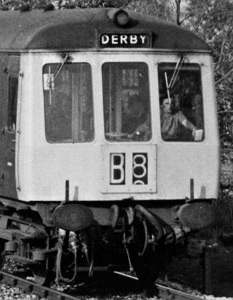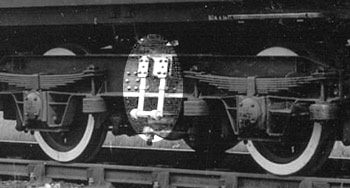Class 114 Derby 2-car DMUs
Exterior


Buffers
As the vehicles were 64ft long it meant more overhang going around curves than for 56ft vehicles, and to avoid buffer lock larger buffers were fitted. Large round buffers were the norm (as on the left), but oval buffers were not unknown to appear on the class (an example on the right).
Marker Lights
Why there was so many variations in marker lights on DMUs may always be a mystery, but the blessing is it often makes for easier identification in photographs. The 114s were built with just one lamp in the centre of the roof dome. Perhaps the ER preferred the use of oil lamps over built-in electric lights, except in the position that wasn't easy to reach? Pictures of oil lamps on the lower brackets on the front of a set are very rare, but tail oil lamps were normal for many years. During refurbishment two lower marker lights were added. Sometimes the top lamp was removed, sometimes it wasn't. When it was there would either be a square or oval shaped patch to cover the hole.
Wipers
The vehicles seem to have been built with just a single windscreen wiper on the drivers side, but a second one added soon after. Yet it wasn't unusual for the wiper blade on the non-drivers side to be removed - as on the above left image - leaving the spindles in place, sometimes the unused spindles (and motor inside) were removed during refurbishment. There was no pattern to this, a seemingly random practice.
Route Indicator
The two-character route indicator went out of use during the all-blue era (1970s) and could then be found wound to white, with the blinds removed exposing the bulbs, or with two large white dots showing. The box was removed during refurbishment.

Bogies
In common with other vehicles built at the time 'external lateral dampers' were originally fitted to the bogies (as highlighted), but were soon removed.
Radiator Fillers
When built the power cars had one radiator filler on each side, which was the norm for most DMUs. By the blue era both fillers were on the non-drivers side.
Coach Board Brackets
These were fitted just below cantrail level. They were removed during refurbishment or soon after.
Summary
Description: General
Description: Cab Design
Description: Power Train
Description: Exterior
Description: Interior
Coupling Code
Diagrams & Works Photos
Numbering & Driving Inst.
Liveries
Operations
Accidents
Refurbishment
Parcel Cars
Non-Passenger Use
Images
Details about preserved Class 114s can be found here.


